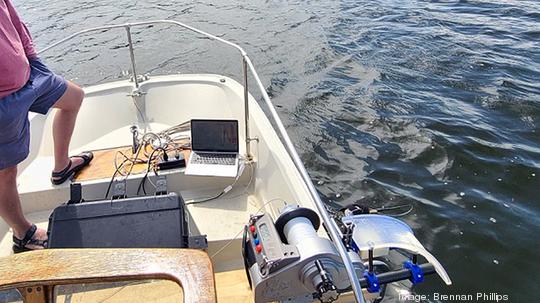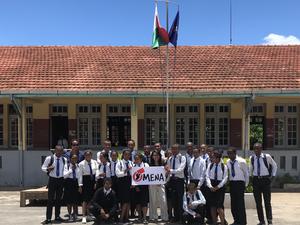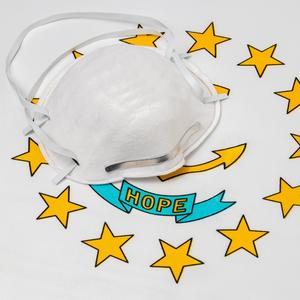
A University of Rhode Island professor and a Pawtucket defense company have teamed up to create the smallest deep-sea, real-time video system in the world.
Brennan Phillips, an assistant professor who specializes in ocean engineering at URI, has partnered with Nautilus Defense to design a system that combines a fiber-optic reel and a tiny camera to produce a live video feed of the deep ocean.
The key to the system is that the fiber-optic cables are wrapped inside a braided fishing line, which is both strong and able to lift heavy items — up to 250 pounds — and can also create the fiber-optic link.
“I can claim it’s probably the smallest deep-sea live telemetry system in the world. ... What that means to me is that you have something deep in the ocean and you are communicating with it in real time,” Phillips told Rhode Island Inno. “Wouldn’t it be cool if you could go out there with a small boat and explore the deep ocean? There’s no system that was out there to do that with a live link.”
According to Phillips, normally, to get a video feed of the deep ocean, fiber optics need to be buried within very heavy cables with a lot of weight that are spooled onto large winches, which results in a fairly large system.
Phillips, who specializes in developing new instruments for oceanographic research, has long thought there is a better, more accessible and cost-effective method to explore the deep ocean. His love of fishing made him think about the braided line, which resulted in him approaching Jim Owens, a principal at Nautilus Defense, to see if it would be possible to encase the fiber-optic cable within the fishing line, and Nautilus delivered.
Then Phillips attached a special oceanic camera he previously had invented to the end of the fiber-optic reel to create the system. This was no easy task because you can’t tie knots at the end of the fishing line without breaking the fiber optic cable on the inside. So Phillips and his lab created a mechanical termination that took the weight of the camera and isolated it from the fiber optic at the end of the line.
The system is placed on the back or side of the boat to lower the fiber optic line and camera into the ocean. The fiber-optic reel is then placed into a little box that converts it into ethernet, which is then plugged into a computer to provide the video feed.
Phillips said early testing of the system resulted in failures, but last summer during the pandemic, he and the team went out in a 30-foot boat and deployed the system successfully. Then he and his team did a project in Bermuda and managed to deploy the system with a 780-meter fiber-optic reel, and the hope is to push an 1,000-meter fiber-optic reel soon.
“The fishing line is the hardest part,” said Phillips. “That’s something special that has been a challenge for Jim and Nautilus, but they’ve stepped up to it every time.”
Since initially developing the system and running the tests, Phillips has now published a research paper and Nautilus and URI have filed a co-patent for the system.
There could be a huge market and many uses for a device like this. Not only will the system have value to the defense sector and the Navy, but it could help oceanographers with their research because they can easily travel with it.
However, there is still a lot of work to do to perfect the fiber optic reel and the overall system.
The good news is the Office of Naval Research has taken notice of Phillips’ work and granted him a Young Investigator Award, which comes with a three-year $510,000 grant.
Phillips and his team have already changed the way they deploy the reel beneath the water. They also plan to work on making the reel longer. Phillips said the current deployment system can hold 2,000 meters, but will be able to hold more in the future. It’s also not just about deploying the line deeper, but also making sure it is able to travel through the ocean horizontally without breaking.
There is also additional functionality that Phillips thinks can be added to the system such as adding depth sensors and temperature sensors and other software. So while the current system is a big achievement, there is much more progress that can be made, a process that Phillips is looking forward to tackling.
“It’s just kind of serendipitous that this company in Rhode Island existed and we could work together to make this product,” he said. “It’s really fun.”








